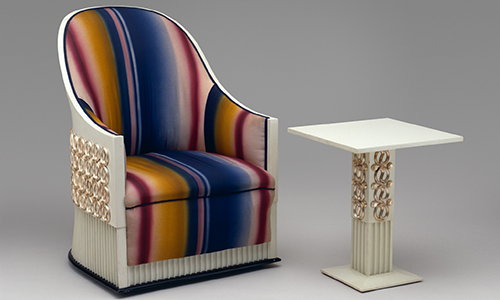- Events & Programs Home
- Calendar
- Accessibility
- Adults
-
Families & Teens
- Families & Teens Home
- 10x10 Teen Art Expo
- Art on the Rise
- Art Together: Art Making for Families with Children Ages 3–5
- Babies Sing with May Festival Minis
- Boy Scouts / Girl Scouts
- CAM Kids Day
- Family Storytime and Gallery Walk
- Family Studio: Art Making for Families with Children Ages 6–12
- Games in the Galleries
- Members-Only Baby Tours
- Public Baby Tours
- REC Reads
- Rosenthal Education Center (REC)
- Saturday Morning Art Class
- See Play Learn Kits
- Summer Camp
- Teen Fest: Zine and Comic Exchange
- RECreate
- Teachers
- Community Outreach
- Fundraisers
- Plan Your Own Event

- Events & Programs Home
- Calendar
- Accessibility
- Adults
-
Families & Teens
- Families & Teens Home
- 10x10 Teen Art Expo
- Art on the Rise
- Art Together: Art Making for Families with Children Ages 3–5
- Babies Sing with May Festival Minis
- Boy Scouts / Girl Scouts
- CAM Kids Day
- Family Storytime and Gallery Walk
- Family Studio: Art Making for Families with Children Ages 6–12
- Games in the Galleries
- Members-Only Baby Tours
- Public Baby Tours
- REC Reads
- Rosenthal Education Center (REC)
- Saturday Morning Art Class
- See Play Learn Kits
- Summer Camp
- Teen Fest: Zine and Comic Exchange
- RECreate
- Teachers
- Community Outreach
- Fundraisers
- Plan Your Own Event
Gondola Chairs
Gondola Chairs
- Home
- Plan Your Visit
- Art
-
Events & Programs
- Events & Programs Home
- Calendar
- Accessibility
- Adults
-
Families & Teens
- Families & Teens Home
- 10x10 Teen Art Expo
- Art on the Rise
- Art Together: Art Making for Families with Children Ages 3–5
- Babies Sing with May Festival Minis
- Boy Scouts / Girl Scouts
- CAM Kids Day
- Family Storytime and Gallery Walk
- Family Studio: Art Making for Families with Children Ages 6–12
- Games in the Galleries
- Members-Only Baby Tours
- Public Baby Tours
- REC Reads
- Rosenthal Education Center (REC)
- Saturday Morning Art Class
- See Play Learn Kits
- Summer Camp
- Teen Fest: Zine and Comic Exchange
- RECreate
- Teachers
- Community Outreach
- Fundraisers
- Plan Your Own Event
- Give & Join
- About
- Tickets
- Calendar
- Exhibitions
- Collections
- Blog
- Shop
- Art
- Exhibitions
- What, Me Worry? The Art and Humor of MAD Magazine
- Recall. Reframe. Respond. The Art of Paul Scott
- Rediscovered Treasures
- Special Features
- Upcoming Exhibitions
- Past Exhibitions
- Online Exhibitions
- Explore the Collection
- Provenance and Cultural Property
- Conservation
- Meet the Curators
- Digital Resources
- Art Bridges Cohort Program

Gondola Chairs, 1921, Joseph Urban (American, b. Austria, 1872–1933), wood, paint, silver leaf, mother-of-pearl, and reproduction upholstery, Detroit Institute of Arts, Gift of Jerome M. Shaw
Verbal Description
Hello, my name is Caitlin Tracey-Miller and I am Assistant Director of Visitor Research at the museum. I will be reading the verbal description for the Gondola Chairs in Unlocking an Art Deco Bedroom by Joseph Urban.
These Gondola Chairs from 1921 are wood, paint, silver leaf, mother-of-pearl, and have reproduction upholstery. They were designed by Joseph Urban, an Austrian-born American who lived from 1872 to 1933. They are in the Detroit Institute of Arts collection and were a gift of Jerome M. Shaw.
This set of Gondola Chairs has a half-circular shape with a curved back that slopes into thin arms. The back, insides of the arms, and seat are upholstered in a striped cobalt blue, light pink, gold, and burgundy ombre pattern. The stripes run vertically and are of varying widths. The back and sides of the chair are finished in a pale-tea-colored enamel with mother-of-pearl and silvered embellishments.
Label Copy
Hello, my name is Caitlin Tracey-Miller and I am Assistant Director of Visitor Research at the museum. I will be reading the label for the Gondola Chairs in Unlocking an Art Deco Bedroom by Joseph Urban.
These Gondola Chairs from 1921 are wood, paint, silver leaf, mother-of-pearl, and have reproduction upholstery. They were designed by Joseph Urban, an Austrian-born American who lived from 1872 to 1933. They are in the collection of the Detroit Institute of Arts and were a gift of Jerome M. Shaw.
It is easy to imagine an elegant, confident Viennese woman, like those often portrayed in Gustav Klimt’s paintings, posed in one of Urban’s gondola chairs. Even to today’s eyes, the chairs look futuristic. Their cool, simplified lines, "pale-tea-colored enamel" finish, and mother-of-pearl and silvered embellishments perfectly complement their bright-striped Viennese silk upholstery. (Note the similarity between the stripe pattern used here and that used in the Wormser Bedroom.) Designed by Urban and made by artisans in his Yonkers studio, these chairs and matching table set the tone for visitors to the Wiener Werkstätte of America showroom. Positioned in the shop’s octagonal reception room, they framed Klimt’s The Dancer (1916–1917)—the first Klimt painting to enter the United States. The side table held a modern silver tea set.
Cincinnati, OH 45202
Toll Free: 1 (877) 472-4226
Museum Hours
Museum Shop
Terrace Café
Library
Cincinnati Art Museum is supported by the tens of thousands of people who give generously to the annual ArtsWave Campaign, the region's primary source for arts funding.

Free general admission to the Cincinnati Art Museum is made possible by a gift from the Rosenthal Family Foundation. Exhibition pricing may vary. Parking at the Cincinnati Art Museum is free.
Generous support for our extended Thursday hours is provided by Art Bridges Foundation’s Access for All program.

General operating support provided by:



